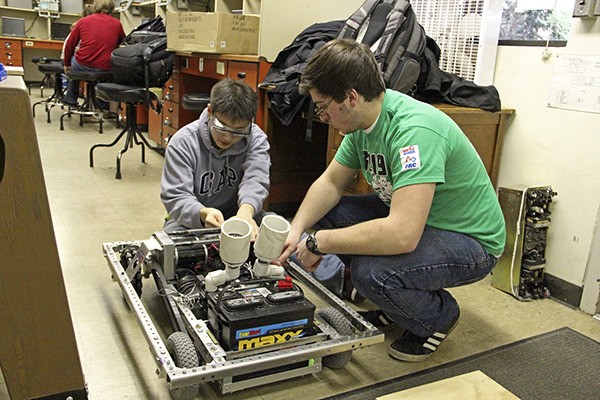When Auburn High School senior Ryan Hubbard looks at the banners decorating his school’s gymnasium – tributes to the success of Trojan teams past – he knows something is missing.
Hubbard, the CEO of the Auburn TREAD 3219 FIRST Robotics Team, hopes that one day his team’s banner – the Chairman’s Award won March 15 at a FIRST Robotics district competition in Mount Vernon, hangs with the others.
“We want to be able to display that and show what we’ve won and how proud we are of what we’ve done with this program over the last six years,” Hubbard said. “”It’s the most prestigious award given to a FIRST Robotics team at a competition.”
Originating in 1989, FIRST – which stands for For Inspiration and Recognition of Science and Technology – hosts an annual series of robotic competitions where clubs assemble robots and program them to compete in a game with other member clubs.
And at every competition, the team that best embodies the message of FIRST is awarded the Chairman’s Award, Hubbard said.
“It’d be great to show that off to everyone,” he said.
Even greater would be the chance to hang that banner when TREAD 3219 hosts its own regional competition March 28-29 at Auburn High School.
The event features 35 teams from teams all over the state competing in this year’s event, Aerial Assault (see below).
For Hubbard, who plans to study electrical or aeronautical engineering at college after graduation, it all started three years ago, when he first turned out for TREAD 3219.
This year, Hubbard said, he decided to go all in and lead the team as CEO.
“This year it’s been a little different; each year it’s a different leadership role,” he said. “I’m trying to take a new tack and try to appeal to as many people as possible and attract as many people as possible to the team.”
Among his priorities was building numbers for the team.
“In recent years, we’ve been having trouble keeping students interested and using them the following years,” Hubbard said. “It’s been hard to replace people in certain positions.”
Typically, Hubbard said, the team attracts numbers at the beginning of the build season but loses them as it rolls along.
“It just tends to fall off, but we’re trying to keep them, and I feel we’ve been successful this year.”
Normally, the team boasts about 30 students. This year the team’s official roster is 55.
The numbers have allowed the team to focus on more than just building a robot to compete.
“We’ve been able to work towards some areas we haven’t been able to concentrate on in the past,” Hubbard said. “We’ve been able to do more with media and public relations. And imagery. Our logo is the same, but we’ve had people design more buttons and other things.”
The diversity the team has gained via the increase in membership, he said, was crucial to winning the Chairman’s Award.
“They saw that our team’s main goal was to spread the message to other people and get the word out about FIRST,” Hubbard said.
Hubbard credits his work with FIRST over the past three years for helping him decide what he wants to do with his life.
“I found out I wanted to be either an electrical engineer or an aerospace engineer,” he said. “Before FIRST, I had no idea I wanted to go into that field. Thanks to this program, I learned how important math and science are and how you can connect the dots between ideas and theories in your trigonometry or calculus class and put that towards building these really cool robots. As an engineer, I can build airplanes and other things, other than just robots.”
Even though TREAD 3219 has already earned a shot at competing for a regional Chairman’s Award on April 10-12 at Veteran’s Memorial Coliseum in Portland, the team hopes to do well at the Auburn district competition and earn a chance to move on based on its performance at the Auburn Districts.
But that, Hubbard said, will take a little tinkering,.
“We haven’t even used the shooter on our robot,” he said. “We’re hoping to get it working so we can get a better alliance and do better in the competition.”
AERIAL ASSIST is played by two competing alliances of three robots each on a flat 25-by 54-foot field, straddled by a truss suspended just over 5 feet above the floor. The objective is to score as many balls in goals as possible during a 2-minute, 30-second match. The more each alliance scores and the more they work together to do it, the more points they get.
The match begins with one, 10-second Autonomous Period when robots operate independently of drivers. Each robot may begin with a ball and try to score it in a goal. Alliances earn bonus points for scoring balls in this way, and for any of their robots that move in to their zones. Additionally, each high/low pair of goals is designated “hot” for five seconds, but the order of which side is first is randomized. For each ball scored in a “hot” goal, the alliance earns additional bonus points.
For the rest of the match, drivers remotely control robots from behind a protective wall. Once all balls in autonomous are scored, only one ball is re-entered in to play, and the alliances must cycle a single ball as many times as possible for the rest of the match. With the single ball, they try to maximize their points earned by throwing balls over the truss, catching balls launched over the truss, and scoring in the high and low goals on the far side of the field.
Alliances receive large bonuses for “assists,” which are earned for each robot that has possession of the ball in a zone as the ball moves down the field.



